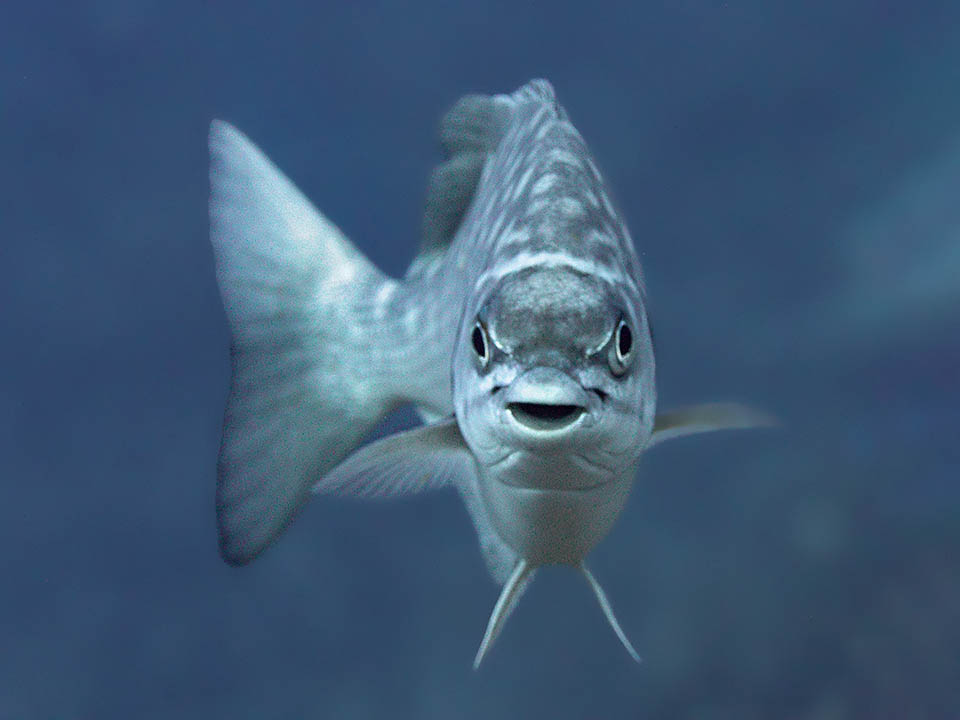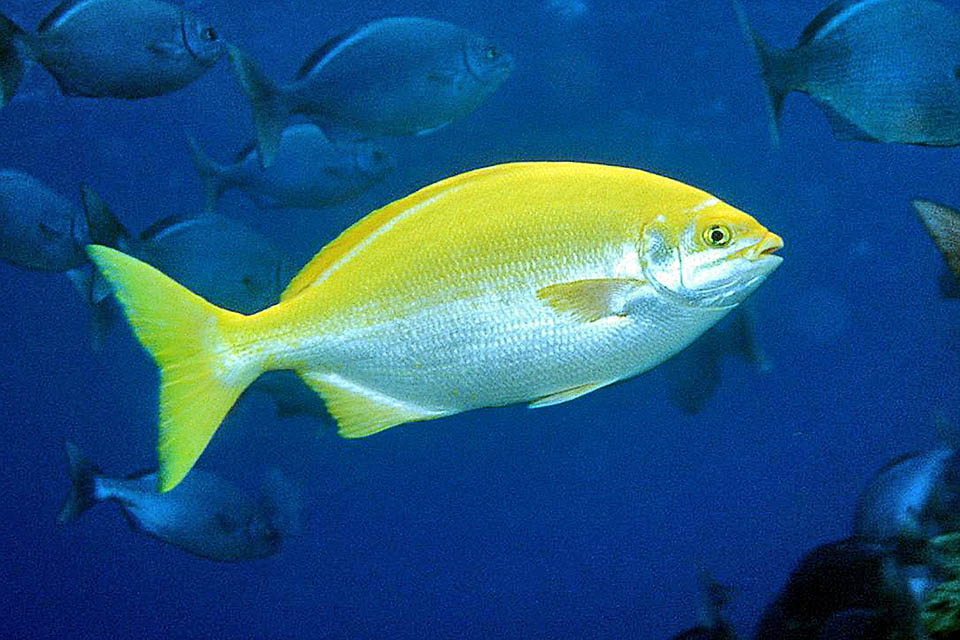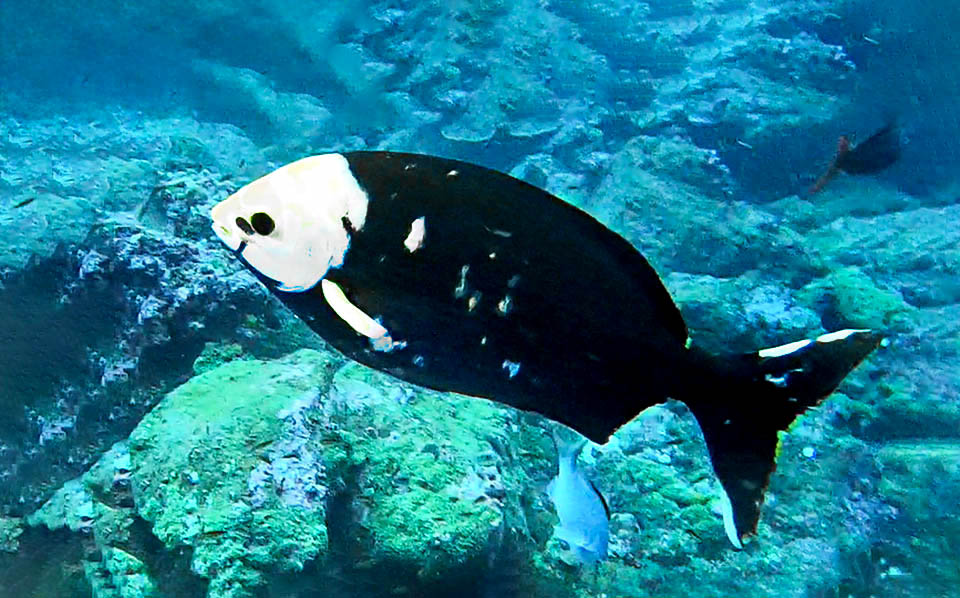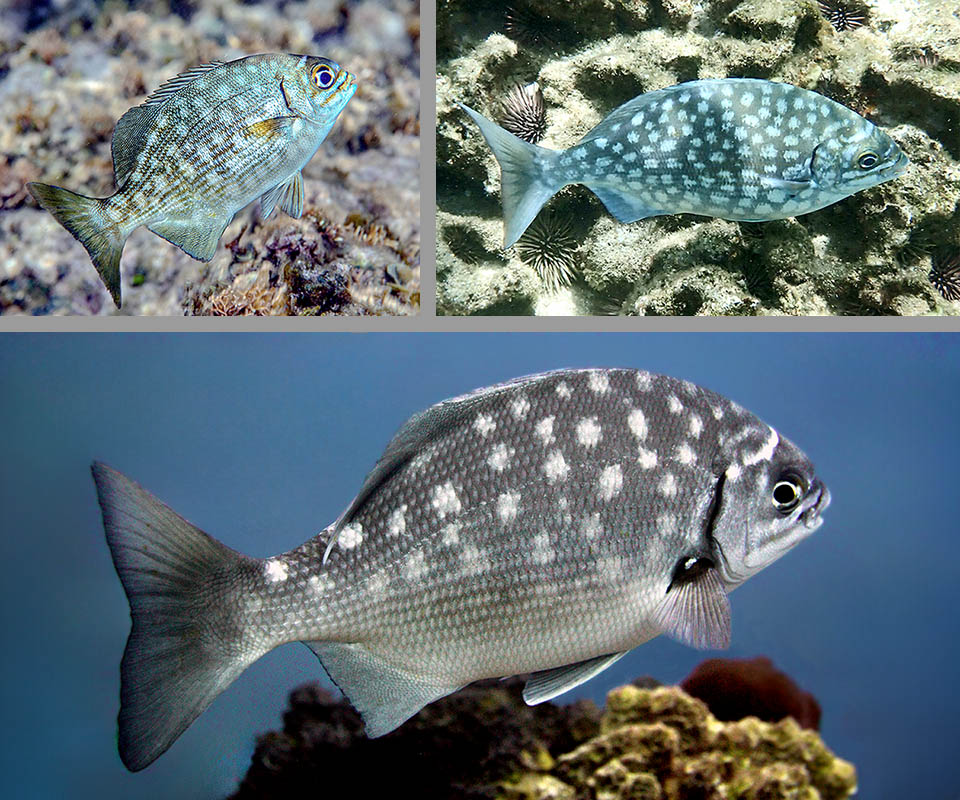Family : Kyphosidae

Text © Giuseppe Mazza

English translation by Mario Beltramini

Kyphosus sectatrix is an ubiquitous fish present in all temperate and warm waters, Mediterranean included © Dan Schofield
Similar in several aspects to the Salema porgy, (Sarpa salpa), Kyphosus sectatrix (Lacépède 1801), does not belong like this one to the family of the Sparidae but to that of the Kyphosidae inserted in the class of the Actinopterygii,the ray-finned fish, and in the order of the Centrarchiformes counting only 2 genera and 16 species.
The genus Kyphosus comes from the Greek “kyphos”, curved, hunchbacked, probably due to its profile, but some assert that Lacépède created it by mistake, as prove the drawings united to the previous description of Kyphosus bigibbus that display a specimen deformed because a bullet-shaped lump on the neck.
The specific term sectatrix, follower in Latin, instead originatesfrom the fact that these fish do often follow the ships to eat the food leftovers thrown into the sea.

It eats mainly vegetables, but also small crustaceans and mollusks. It follows the vessels for the leftovers thrown at sea and doesn’t disdain the dolphin feces © www.carlosestape.photoshelter
Zoogeography
Kyphosus sectatrix is practically present in all temperate and warm waters, Mediterranean included, and in the brackish ones of the river mouths.
Starting from west Atlantic, it is found, for instance, from Massachusetts and the Caribbean up to Brazil; then, offshore, at the islands of St. Paul’s Rocks, Trindade and Martim Vaz, Saint Helena, Ascension, Cape Verde, Canaries, Madeira and Açores. To the South it reaches the coasts of Cameroon and of Angola and, northwards, the English Channel after having touched Portugal, Spain and France.
In the Indian Ocean it has been sighted at Réunion and in Indonesia. In the Western Pacific, north to Australia, it reaches Japan and southwards the Kermadec Islands and northern New Zealand. Eastwards it is found in Polynesia, the Hawaii and the Revillagigedo Islands, now close to Mexican coasts.

The normal livery is grey, at times with dark or golden longitudinal streaks, but in the oceanic islands it may be even yellow © Malcolm Francis
Ecology-Habitat
Kyphosus sectatrix can dive up to a depth of 30 m but usually lives in surface waters between 1 and 10 m where the temperature is between 20,1 and 28 °C. It frequents different environments but especially submerged prairies of sea phanerogams with a preference for Thalassia testudinum, known also as Turtlegrass because in addition to offer a rich pasture to the herbivorous fish is very appetite by these big reptilians.
The juveniles often grow camouflaged in the vast drifting masses of sargassoes.
Morphophysiology
The current length of Kyphosus sectatrix is 50 cm, with a published maximum of 76 cm and 6 kg.

Reproduction happens in big groups which are also at times joined by groupers. The huge number of eggs entrusted to the currents thus reduces the predation possibility © Thomas Menut
The body is elliptical with the head descending from above the eye to the snout ending in a small horizontal mouth, armed on the jaws with one row of incisor teeth forming a sort of plate, ideal for cutting the vegetables forming its main course. Naturally it does not leave out the small crabs and the mollusks that are unfortunate enough to be in the vicinity, and it has been seen greedly devouring the feces of the Spinner dolphin (Stenella longirostris).
The dorsal continuous spine originates far from the head. It has 11 spiny rays and 11-12 soft folding into a groove while swimming; the anal, shorter, 3 spine and 11 unarmed rays; the pectoral ones have 17-19 rays and the pelvic, relatively short, are located a little further back; the caudal, dark as the dorsal and the anal, is forked and serrated.
The body is grey or lightly silver, at times with dark or golden longitudinal streaks. We note a light area under the eyes bordered by a yellowish line going from the mouth to the preoperculum.

For the occasion males appear black with white head. They go up with the partner 4-5 m over the school, soon imitated by the other couples © Billy Bensted-Smith
At times, especially along the oceanic coasts, we note bright yellow individuals, sometimes with black spots or clear or whitish zones. The juveniles are grey, with white or clear spots, present on the body and on the fins, having the same size as the eyes.
Ethology-ReproductiveBiology
In the mating season, between January and March, a few days after the full moon, in places known. to fishermen, take form for the deposition schools with hundreds of individuals. Gatherings that often coincide with those of some groupers like Epinephelus striatus or Plectropomus laevis contributing to reduce, seen the huge number of eggs entrusted to the currents, the risk to be preyed upon.
Like for this species, the males take on for the occasion a particular livery in white and black and here they catch the eye due to the candid head standing out on the almost black body.

Juveniles have light camouflage dots on the body and on the fins the same size as the eyes. Here three growing stages © Frank Krasovec (top left) © Pierre-Louis Stenger (top right) © Dan Schofield (bottom)
They are the ones who start the depositions going up with their partner 4-5 m over the school to entrust the gametes to the currents. This stimulates the males of the other couples, and in a short time they all find themselves at the top.
The resilience of the species is low with a minimum time of 4,5-14 years for doubling the populations and even if its flesh is not valuable the fishing vulnerability is moderately high, marking 50 on a scale of 100. Due to the vast diffusion Kyphosus sectatrix however appears since 2012 as “LC, Least Concern”, in the IUCN Red List of the endangered species.
Synonyms
Perca sectatrix Linnaeus, 1758; Kyphosus atlanticus Sakai & Nakabo, 2014.
→ For general information about FISH please click here.
→ For general information about BONY FISH please click here
→ For general information about CARTILAGINOUS FISH please click here.
→ To appreciate the BIODIVERSITY of BONY FISH please click here.
→ To appreciate the BIODIVERSITY of CARTILAGINOUS FISH please click here.
